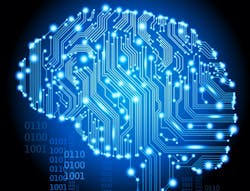Military researchers interested in artificial intelligence (AI) and machine learning for sensor processing
ARLINGTON, Va. – U.S. military researchers are notifying industry of their interest in reconciling and organizing information from separate sensors in an effort to enhance artificial intelligence (AI) and machine learning technologies.
Officials of the U.S. Defense Advanced Research Projects Agency (DARPA) in Arlington, Va., issued a special notice (DARPA-SN-22-36) on Thursday for the Enabling Confidence project of the Artificial Intelligence Exploration (AIE) program.
Accurate processing of covariance information related to environmental variations and noise from sensors is paramount to how well that statistics-based estimators like Kalman filters perform in sensor processing, and is the key enabler for combining information from several sensors, DARPA researchers explain.
Covariance is a measure of how two random variables differ; if the greater values of one mainly correspond with the greater values of the other -- and the lesser variables tend to show similar behavior -- the covariance is positive. Conversely, when the greater values of one variable mainly correspond to the lesser values of the other, the covariance is negative.
Related: Artificial intelligence: the intelligence analyst's friend
The Enabling Confidence project will develop scalable ways to generate covariance information for machine learning systems to enhance performance when combining several subsystems. It encourages using machine learning approaches like deep learning and Bayesian techniques.
Specifically, DARPA researchers want to know if a machine learning system output covariance can reflect sensor and environmental covariance information. Also, can computer scientists develop machine learning subsystems hierarchically to increase inference accuracy?
Researchers also want to know if systems integrators could combine these kinds of machine learning systems with statistics-based estimation, like Kalman filters, to reduce errors.
DARPA researchers seek to overcome two primary challenges in this project. First, simple covariance measures often are insufficient to characterize output uncertainties after sensor and environmental variations propagate through the machine-learning architectures.
Second, nonlinearities in existing machine-learning architectures make direct calculations difficult to control, and approximate methods degrade performance.
The Enabling Confidence project will last for 18 months, with a nine-month first phase, and a nine-month second phase. The first phase will demonstrate the feasibility of generating accurate output covariance for realistic machine learning by experimentally validating the resulting system covariance model using cross-correlation measurements.
The second phase will demonstrate the feasibility of edge deployment of these technologies by demonstrating a 10x speedup in covariance generation over the first phase; and demonstrate lower errors in an estimation task by linking a machine learning subsystem with a conventional statistics-based estimator.
This notice is for information and planning purposes only, and is not yet a formal solicitation. Email questions or concerns to Enabling [email protected]. More information is online at https://sam.gov/opp/85d024ca121f4211b044642f04e95cc8/view.

John Keller | Editor-in-Chief
John Keller is the Editor-in-Chief, Military & Aerospace Electronics Magazine--provides extensive coverage and analysis of enabling electronics and optoelectronic technologies in military, space and commercial aviation applications. John has been a member of the Military & Aerospace Electronics staff since 1989 and chief editor since 1995.

